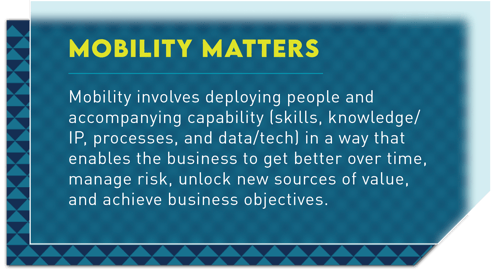- Financial Services
- Life Sciences
- Health & Human Services
- Transportation
- Auto and Manufacturing
- Energy & Utilities
- Emergency Management
- Healthcare
- Managed Services
Post-pandemic, leaders in Health and Human Services (HHS) focused on a shift toward a more holistic approach to care. Known as “whole-person care,” this approach considers all aspects of a patient’s health, including physical, behavioral, and importantly, social elements. This forward-thinking strategy relies on improved data and analytics (D&A) and interoperability, or enhanced collaboration between different agencies and vendors. However, the journey toward whole-person care faces significant challenges, with fragmented and isolated operations and historically high workforce shortages taking center stage. To overcome these obstacles and effectively address health inequality through more holistic care, HHS agencies must proactively modernize their strategies and embrace interoperability. In the following blog, we delve into an effective approach for achieving this goal: a talent mobility system that promotes knowledge sharing and cross-functional collaboration. The key lies in consciously cultivating robust capabilities instead of over-relying on narrow skill sets. By adopting this approach, HHS agencies can fortify their workforce, enhance retention rates, and make substantial strides toward achieving health equality.
Amidst record-breaking strikes and walkouts, one of the key challenges facing the public transportation sector is the overwhelming workforce shortages reported by 96 percent of US transit agencies. The allure of higher pay, more innovative projects, and remote work options has enticed a significant number of public transportation workers to move to the private sector. Employee desires are clear: they want more pay, increased growth opportunities, and greater flexibility in their work arrangements. Adding to internal demands for change, transportation players are facing external pressures for carbon-neutrality and sustainable practices from the government and consumers. To address both internal and external challenges and expectations, the industry must take an approach that puts people at the center. In other words, leaders must prioritize internal workforce efforts, namely capability development. By building robust capabilities, rather than just focusing on specialized skills, you can build a more mobile workforce that is equipped to drive change and answer the call for a greener future. Talent mobility also plays a crucial role in creating growth opportunities for employees, leading to enhanced employee engagement and retention. Find out more in the blog below.
The automotive and manufacturing industry is experiencing a strong rebound post-pandemic, prompting dealers and original equipment manufacturers (OEMs) to reevaluate supply chains, retailing, and workforce management. With component shortages pushing buyers towards used cars and showrooms quieter than usual, companies are ramping up digital marketing, sales processes, and talent development efforts. However, the pandemic's lingering effects have resulted in a high employee turnover rate of 46 percent for auto dealers. As the industry aims to accelerate into electric vehicles (EVs) while improving sales and service for internal combustion engine (ICE) vehicles, it must focus on building capabilities in its workforce, rather than just specialized skills. A workforce with robust and versatile capabilities enables talent mobility, empowering companies to adapt swiftly to market demands and embrace technological advancements. It also helps mitigate the impact of talent shortages and ensures business continuity. By building capabilities and offering a conducive environment for employee learning and growth, companies can attract, retain, and continuously upskill a versatile and in-demand workforce, leading to enhanced productivity and long-term success. Learn more in the blog below.
The energy and utilities (E&U) industries, like others, are navigating a landscape of rapid technological advancements and ever-changing market demands. However, they face an additional challenge: building the next era of energy innovation within traditional and rigid systems, all while sticking to regulatory deadlines. To make things tougher, there's a scarcity of skilled employees required to drive these changes. In light of these circumstances, it becomes vital for E&U companies to leverage the talents of their existing employees to stay competitive. They need to rethink and reskill their workforce, empowering people to meet the demands of new energy transition mandates and explore new career opportunities and development paths. But how can they do this effectively? One increasingly important solution, which we explore in the blog below, is to build robust capabilities rather than specialized skills. This is essential in today’s landscape because capabilities enable talent mobility, which is all about strategically moving employees internally within the organization to respond quickly to changing market demands and make the most of limited resources. Talent mobility creates a more agile and adaptable workforce, allowing companies to embrace innovation, which is especially important in times of workforce shortage and as the E&U sectors continue to face fluctuations in demand, regulatory changes, and technological disruptions. In the below, discover the three common barriers to talent mobility and how to overcome them. We’ll leave you with a better understanding of how to unlock the potential of your existing workforce and navigate the challenges of today's dynamic landscape with confidence.
The future of emergency management is getting more intricate, unpredictable, and interconnected, requiring smooth, data-driven, and collaborative internal operations. However, emergency management organizations still face significant challenges. They must attract and retain skilled professionals while dealing with the increasing frequency and cost of natural disasters, along with the growing impact of man-made crises like cyberterrorism, unauthorized immigrants, and the Covid-19 pandemic. Additionally, the necessary capabilities to handle these ever-changing threats are constantly evolving. With limited resources and the need for swift and transparent responses to a rising number of emergencies, emergency management organizations must focus on building a versatile workforce. This means being prepared to quickly pivot and deploy the right people and resources when and where they are most needed, leading to faster response times, reduced impact, and greater recovery success with each new emergency. To achieve this, it's crucial to focus on building capabilities over relying solely on specialized skills. In the blog below, we explore the top three barriers to talent mobility and explain how to develop operational resilience through robust capabilities. By proactively designing and growing optimized people, systems, and processes, organizations can leverage these capabilities with decisive precision when disaster strikes.
As healthcare organizations continue to recover from the Covid-19 public health emergency, they must redefine the way they respond to persisting vulnerabilities. Namely, workforce burnout, patient overflow, and outdated systems and technologies. But overcoming these challenges requires healthcare organizations to focus on long-term, sustainable strategies that enable lasting transformation. And doing so effectively requires starting from within, and tackling the primary challenge identified by 58 percent of medical practices: staffing and workforce development. Healthcare employees are often over-worked and under-supported, making it essential for leaders to provide them with systems and ways of working that motivate, engage, and inspire. It’s time for this industry to switch back from mainly managing productivity of its workforce to enabling purpose. And the best way to achieve this is by growing future-ready capabilities and implementing a talent mobility system. In the following, we explain how talent mobility and ongoing capability development not only enhance employee engagement and satisfaction, but also bolster retention rates. You will also find the three barriers to talent mobility with expert solutions for overcoming them.
Vasyl “Loma” Lomachenko is one of the most successful amateur boxers of all time and is widely regarded as one of the most technically skilled boxers to ever compete. He grew up in a family of fighters in Ukraine; his father was his coach. And in a competitive field dominated by single-sport specialists, Lomachenko’s father believed in the value of variety. He encouraged his son to participate in gymnastics, basketball, football, and tennis, all while he was attempting to build a world-class boxer. Lomachenko even quit boxing altogether for four years between the ripe talent-development ages of nine and 13 to master traditional Ukrainian dance.
“Ultimately, everything came together with all those different kinds of sports to enhance my footwork,” Lomachenko told The Guardian in 2018.
In an era of rapid change and workforce shortages, companies must adopt the nimble footwork of a world-class boxer—who happens to moonlight as a dancer—with a talent mobility strategy that enables continuous data-driven pivots.
How? Amidst a flurry of upskilling and reskilling, businesses must continuously inventory, measure, and build capabilities, not just skills.

The demand for skills is evolving at an unprecedented pace. Just three months ago you might have recruited someone to fill the role of prompt engineer for ChatGPT. However, with the lightning-fast rise of CoPilot and other game-changing technologies, the skill requirements for that very position have been turned upside down. This exemplifies just how crucial it is not to be swept away by the flashy trends or moments in time, but to stay focused on the bedrock: the capabilities that can tackle complex end-to-end challenges and applications.
While skills are of course necessary, they don’t enable businesses to rapidly assess, adapt, and redeploy. Capabilities do.
To survive, adaptation—powered by continuous re-prioritization—trumps overspecialization. That’s where talent mobility comes into play.
The enablers of high-performance talent mobility
On any given day, emergency rooms across the United States are putting on a master class in the basics of talent mobility.
As new patients enter their care, triage nurses continuously reprioritize and reallocate best-fit resources against the most critical patient needs. The staff in this part of the hospital pivot with ease between broken arms and mental health crises. A smaller number of specialists are part of the triaged care model, but the ER staff bear 50 percent of a hospital’s admissions.
Emergency rooms have been called “a room with a view into our healthcare system,” and a critical indicator of the overall health of a hospital’s bottom line. An ER that is effectively triaged in response to patient needs is linked to higher hospital performance in all units.
Emergency room staff absolutely need clinical skills. But they also need capabilities that are more difficult and time-consuming to build and hire for. For example, they need to have composure; they need to be assertive and decisive; they must be flexible, creative, and masterful multi-taskers.
Today’s businesses need their own version of a well-triaged ER, and they need a talent mobility system to identify, match, and promote capabilities that enable agility, adaptability, and resilience. The right talent mobility system powers a flywheel of ER-speed triaging through:
- Rapid diagnostics
- Continuous reprioritization
- Simultaneous change
- A workforce that is functionally flexible, holistically minded, and centrally-resourced
- Autonomy directed by shared values
- Ongoing capability building
The human resources department plays a critical role in facilitating talent mobility, but the above enablers shouldn’t be siloed in HR. Instead, they must be embedded at all levels, and driven by data providing sightlines into market shifts, consumer preferences, regulatory moods, and ultimately, overall business performance.
This is not to diminish the importance of HR. In fact, the hiring function will significantly impact a company’s ability to maintain a flywheel of talent mobility.
Here’s why: Successful companies will no longer recruit and hire for specific jobs, but instead for the skills and capabilities that best align to company values and can be continuously redeployed.
Companies like AstraZeneca, Microsoft, and Nike have long lived by this hiring philosophy. Microsoft hires people for their growth mindset; AstraZeneca seeks out entrepreneurs. And an employee who shares Nike’s passion for sport, for example, is more willing and better equipped to serve the company wherever they’re needed.
Moreover, companies like Nike know how to build, buy, and borrow to make the most impact. The brand leverages partners where they know specialization doesn’t align with its core values. Its iconic ad campaigns, everything from “Bo Knows” to “There Is No Finish Line,” have always been developed by outside agencies.
Better talent mobility equals improved talent retention
In 2022, a new corporate scorecard ranking the United States’ 250 largest companies on worker advancement capabilities was launched. The American Opportunity Index is a joint project of the Harvard Business School, Burning Glass Institute, and the Schultz Family Foundation, and its presence alone is an indicator of two realities:
- Retention is critical to future readiness; and
- Companies with better talent mobility retain high-value employees longer.
The Retention Requisite
According to research conducted by Forrester in February 2023, 41 percent of respondents say their organization is struggling to meet their transformation goals due to constraints and shortages of qualified talent. These workforce shortages, which are challenging businesses in every industry, aren’t going away any time soon. Declining fertility rates and the rise in baby boomer-era retirees are steadily contributing to a chronic workforce deficit that is critically misaligned with increasing business need. The ability to foster, retain, and maximize talent is an emerging priority and key performance indicator (KPI) as a result of unbalanced supply and demand.
Mobility Matters
According to the Opportunity Index, top performers in talent mobility held onto more than seven in 10 workers after five years, compared to roughly four in 10 amongst the lowest ranked.
Index researchers have found that companies underperforming in talent mobility tend to do so for at least one of the following three reasons:
- They haven't consistently measured outcomes;
- They haven't invested in training; or
- They're adhering to archaic business models.

Correcting for the most common barriers in talent mobility
There is no silver bullet for talent mobility, and it will look different in every company. However, the most common barriers to high-performance talent mobility do look similar, and companies can ensure current and future best practices aren’t stunted by proactively correcting for them.
In the context of mobility, achieving success relies on a twofold understanding:
- Being well-versed in the specific tasks that need to be accomplished (going beyond mere job titles to grasp the actionable work); and
- Having a deep knowledge of your team members. This knowledge includes recognizing their abilities, understanding their ambitions, and pinpointing opportunities where they can thrive and excel through stretch assignments.
It’s a combination of people analytics (data), top-level management, and personal connection that brings mobility to life.
Talent mobility barrier #1: Inconsistent measurement of outcomes.
You can’t improve what you don’t measure. Companies must comprehensively measure talent mobility indicators including:
- Velocity of internal growth;
- Future readiness;
- Homegrown leadership rates;
- Rates of degree- or skills-based hiring; and
- Ratios of promoting up vs. promoting out (employees who leave to accept a promotion with another company), among others.
These indicators—more so than the number of upskilling programs or stretch assignments offered—describe the impact of your talent mobility program and should be used to inform continuous pivots in pursuit of improved outcomes.
To measure talent mobility well, companies must prioritize modernized tech and data architectures and powerful analytics functions. These generate the right insights that dramatically improve a leaders’ ability to prioritize, make decisions, and measure progress. The right tech makes it possible to test and learn and implement necessary changes quickly and at scale.
This applies to functions inside and outside of talent mobility. Data-led organizations generate more insights that demand quick reprioritization. Greater talent mobility allows companies to rapidly respond to those evolving business needs.
Data may not offer ready-made solutions to your problems, but it does serve as a powerful catalyst to stimulating productive conversations that delve into the core challenges you face. By leveraging quality insights, you are prompted to confront and grapple with the true nature of your problems, paving the way for effective problem-solving.
Talent mobility barrier #2: Poor investment in training.
Organizations that focus narrowly on the skills they need to tackle today's priorities will fail to build the capabilities they need to compete tomorrow. Companies must cross-train to be more skills-based and capability focused.
That starts with a clear understanding of the work to be completed, as well as the unique capabilities needed to accomplish that work—a challenge for most companies new to identifying, assessing, and tracking capabilities through robust data management systems.
North Highland helps companies find and apply existing data to gain a clearer, more accurate picture of their talent supply and demand. From this vantage point, companies can easily identify gaps, reprioritize work, redeploy talent, and engage cross-capability, right-fit project teams—often without adding full-time employees.
Forrester found that half (50 percent) of decision-makers are hiring more freelancers, gig workers, and partners when confronted with a skills gap, allowing them to continue to build the right talent internally while meeting immediate business needs.
Based on precise definitions of the capabilities required to meet their unique business needs, North Highland then co-creates the systems to build and manage them. In some cases, effective prioritization calls for a Managed Service (or Teams-as-a-Service). The ability to understand where to build, buy, borrow, or automate with a bot is critical to doing more with less now, while building for the future.
“Just Do It” wasn’t the product of Nike’s internal team; it came from the borrowed brilliance of service partner Wieden + Kennedy. Over time, as Nike evolved into a powerhouse in the art of brand storytelling, it gradually cultivated these capabilities internally. And while they have developed a strong in-house team and resources, the company understands the importance of collaborating with external partners to bring fresh perspectives and expertise to their brand storytelling initiatives. This fusion creates a powerful and effective strategy.
Talent mobility barrier #3: Immobile business models.
Traditional talent management systems are failing most companies. They simply aren’t built to enable reprioritization at the speed of change. Agile processes and operations are the foundation of continuous reprioritization among leaders and the workforce. By building mobility into structures, processes, and operations, companies automate a better flow of knowledge, likely driving productivity as well as accelerating speed to value. In practice, this will look different for each company. For some, it will mean removing barriers and adding tools within an already nimble system. For others, it will require total structural transformation.
At AT&T, it involved tuition assistance, community college partnerships, and apprenticeship programs for its entry-level retail employees. Yet in a silo, these tools alone wouldn’t have earned AT&T top rankings in the Opportunity Index. Its operations and processes at all levels—from employee experience and enablement to C-suite KPIs—demonstrate the company’s commitment to promoting from within, increasing the representation in the workforce, and providing “second chance” workers who have criminal records a fresh start.
In an uncertain talent market, organizations are increasingly turning to transformation partners to help them navigate necessary change. Over the last 12 months, Forrester found that 59 percent of decision-makers engaged external specialists to support transformation within their talent development programs.
Mobilizing for the future
The global financial crisis of 2008 exposed the cracks in a deep-and-narrow approach to talent mobility. While a range of factors contributed to the collapse of 400 banks, the dizzying degree of internal specialization and segregation inside the banks left standing made crisis response difficult.
When a 2009 federal program incentivized banks to decrease mortgage payments for homeowners, several banks severely fumbled the pass between internal units. The mortgage lending unit did what it was supposed to do and reduced homeowners’ monthly payments. Meanwhile, the units that managed foreclosures, upon noticing homeowners paying less, did what they were supposed to do: declared homeowners in default and began seizing properties.
Today, siloed overspecialization can still allow for isolated, high-risk activities, but most critically, it inhibits the adaptation and continuous re-prioritization of talent. To mobilize for the future, companies must redesign how they manage talent to enable the nimble, data-driven choreography of capabilities.











